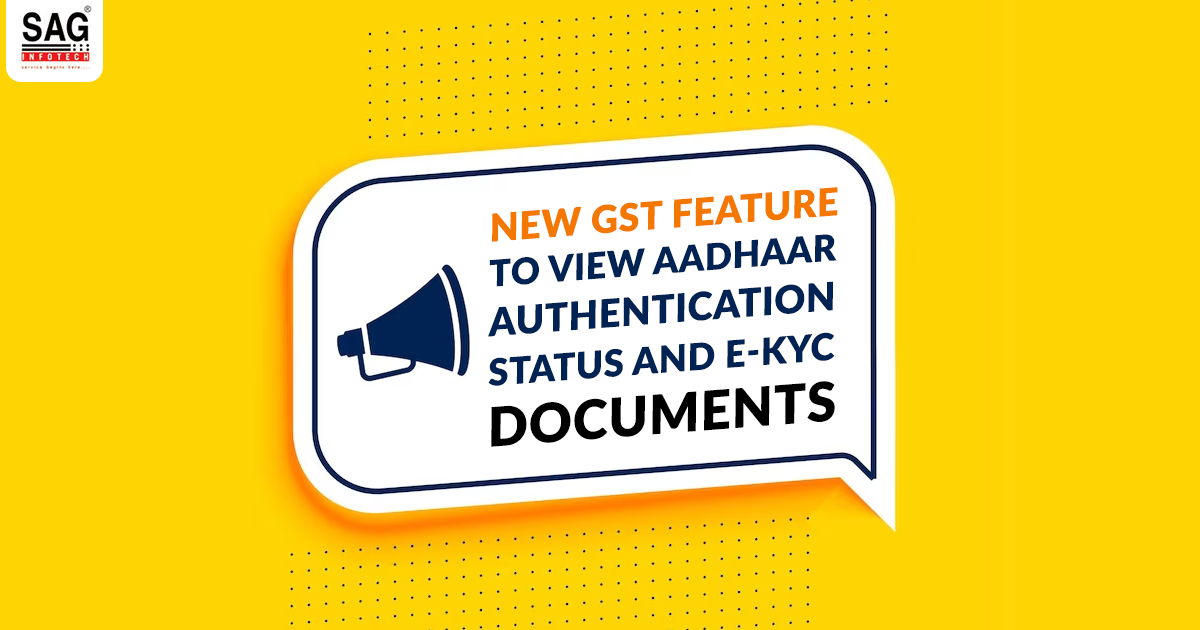
The GST Department has introduced a new feature and issued an advisory regarding the viewing of Aadhaar Authentication Status, downloading e-KYC documents for new registration applications, and uploading e-KYC documents in the PV Report of the CBIC ACES Goods and Services Tax Application.
The Office of the Principal Additional Director General of Systems & Data Management, Goods and Services Tax, and Central Excise issued the advisory.
Under Section 25 of the Central Goods and Services Tax Act, 2017, the implementation of a rule regarding new registration applications has been mandated by GSTN (Goods and Services Tax Network). As per this rule, all types of businesses, including proprietorships, partnerships, and limited companies, are required to undergo Aadhaar authentication during the registration process. These four specific categories are exempted: Government Departments, Public Sector Undertakings, Local Authorities, and Statutory Bodies.
To fulfil the requirement for new registration applicants, there is a specific procedure for authenticating Aadhaar information. Essentially, either one of the key individuals among the proprietors/partners/promoters or the primary authorised signatory among the signatories must complete the Aadhaar authentication process. In simpler terms, at least one person from these groups is required to undergo the authentication process.
In order to ensure Aadhaar authentication for new registration applications and obtain a GSTIN (Goods and Services Tax Identification Number), both the proprietor/partner/promoter and the primary authorised signatory must successfully complete the Aadhaar authentication process on the GST portal. If these roles are assigned to different individuals, both of them are required to undergo the authentication process. However, if the same person fulfils both roles, the Aadhaar authentication by that individual alone is sufficient.
GSTN provides a different option in situations when Aadhaar authentication cannot be completed. When Aadhaar authentication is not possible or is failed, applicants may present E-KYC documents as a valid form of identification.
Following the mandate, applicants’ Aadhaar authentication status can be checked by CPC officers and tax officers who commence or submit PV (provisional verification) reports. They can also see and download any E-KYC files the applicant has supplied if any are available. The ‘Partners Details’ and ‘Signatory’ parts of the new registration application provide these specifics.
Once the application is approved and jurisdiction is assigned, tax officers can carry out similar actions on the GST REG-01 form. Furthermore, CPC officers now have the option to raise inquiries specifically related to e-KYC documents. This can be done through a newly introduced section called ‘E-KYC Documents’, which can be found under the tabs named ‘Authorised Signatory’ and ‘Promoters/Partners’.
New functionality has been added to the ‘Document’ section of form REG-30 (PV report) to facilitate tax officers conducting physical verification (PV). This improvement allows PV officers to upload multiple e-KYC documents of the proprietors/partners/promoters and the primary authorised signatory in file formats such as jpeg, jpg, and .pdf. It is important to ensure that each document should not exceed a file size of 1 MB.
The PV officer can choose from the ‘Partner/Signatory’ column either the proprietor/partner/promoter or the primary authorised signatory when using this feature. Then, under the “E-KYC Document” column, they can select the type of e-KYC document to upload. The PV officer can choose a name from the dropdown list to link the e-KYC document appropriately when there are several partners/promoters.
Read Also: Must-Know Important GST New Functionalities for Taxpayers
The officer must select “Choose file” in the “Document” column in order to upload the document. The officer can add the record to the PV report by clicking the “Add” button after all four columns have been filled in. It must be kept under consideration that the record won’t appear in the PV report after it has been added. To successfully add a record, all four columns must be filled out, and you can add multiple records as well.
By clicking the “delete” icon, the officer can, if necessary, remove any newly added records or clear an active record. It’s critical to keep in mind that once the PV report has been submitted, new changes cannot be made.
In the advisory, it was also made clear that after the formation of the features to production, it is the vendor’s (Wipro) responsibility to address any errors, defects, or bugs that may be detected. Therefore, it is expected that this guideline be shared with all concerned officers in order to seek their precious guidance.
If any issue is noticed in the performance of the new feature, they should be reported promptly to cbicmitra.helpdesk@icegate.gov.in for needed resolution.









